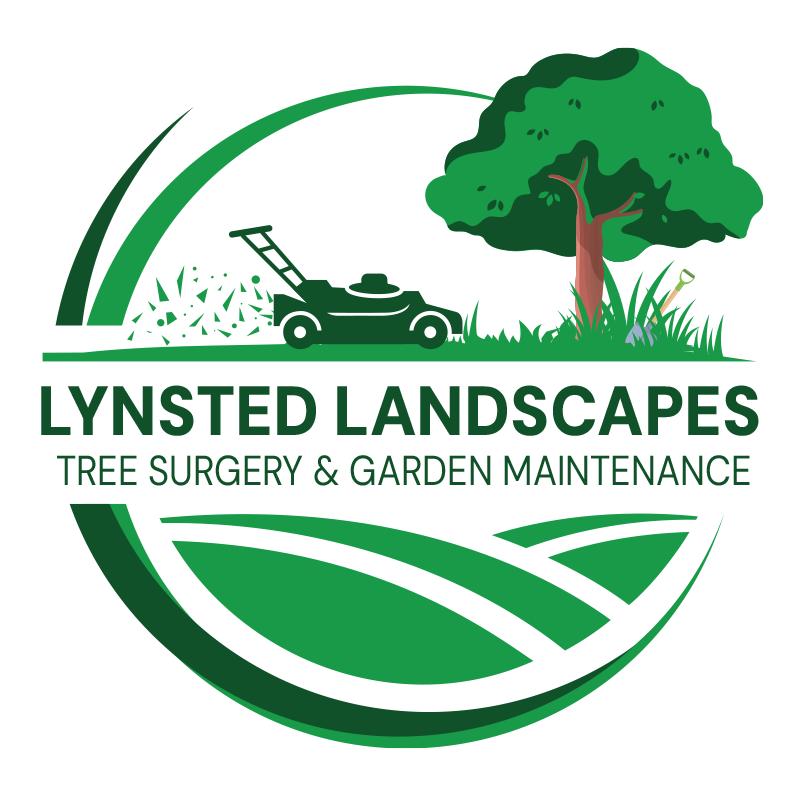Have an overhanging tree from a neighbour’s garden that’s blocking sunlight or dropping leaves onto your lawn? You’re not alone. From overhanging branches and fallen fruit to disputes about a high hedge, trees that cross property boundaries are a common issue for UK homeowners. Legally, you have the right to “abate a nuisance”, which allows you to trim branches that extend over your boundary.
However, it’s important to understand the limits of what you can and can’t do. For example, you are not allowed to access your neighbour’s land without permission, and any trimming must be done from your side of the fence.
Need advice or professional help? Contact Lynsted Landscapes to speak to an experienced team today.
What Does the Law Actually Say—and What Are Common Myths?
Under Common Law in the UK, you are legally allowed to cut back overhanging branches that cross onto your property, but only up to your boundary. You are not permitted to cut anything beyond that, or enter your neighbour’s tree space without permission. Any trimmings, including fruit or wood, still legally belong to your neighbour and must be offered back to them.
One of the biggest misconceptions is that you can remove a tree simply because it blocks your view or creates shade. That’s not true. Trees are protected under various laws, and taking action without proper knowledge could result in legal consequences.
Ownership vs. Responsibility
It might seem logical to assume that if part of the tree is on your land, you can do what you like. But UK law draws a clear line. The tree remains the legal property of the neighbour, and any actions must respect that ownership.
If your neighbour’s tree drops leaves or fruit onto your garden, unfortunately, you cannot force them to remove it. These are considered natural occurrences. However, if the roots damage your property, or the branches threaten safety, you may have grounds for a nuisance claim.
Key UK Laws to Know
There are a few legal frameworks to keep in mind:
- Common Law Nuisance: Allows action when trees cause real interference with the use or enjoyment of your property.
- Tree Preservation Orders (TPOs): Protect certain trees. Pruning or felling without permission could lead to prosecution.
- Conservation Areas: Additional restrictions apply in protected zones.
- High Hedges Act: Applies when a high hedge made up of two or more evergreen trees affects your enjoyment of your home.
When You Need Permission
If a tree is covered by a TPO or located in a conservation area, you must apply to your local council for permission to carry out any work. This applies even if the tree is growing over your boundary. A qualified tree surgeon can help you navigate this process and ensure the job is done safely and legally.
At Lynsted Landscapes, we have years of experience managing tree disputes. Whether you need careful pruning, professional inspections, or full tree maintenance, our team is here to help.
Assessing the Situation: Safety, Boundaries, and Common Sense
When a neighbour’s tree starts encroaching into your space, blocking the light entering your garden or home, it can be tempting to act quickly. But it’s important to step back, assess the situation properly, and follow a smart approach. Understanding your rights around tree preservation, safety, and property boundaries will help you make informed and neighbourly decisions.
Before You Grab the Shears
Start by identifying the root of the issue. Is the tree trunk on their land? Are tree roots lifting your patio? Are high hedges shading your windows or causing your gutters to overflow? Rushing in could cause increased tension, damage, or even legal missteps.
Boundary Check Matters
Official title deeds and boundary plans are useful, but they don’t always tell the full story. Talk to your neighbour to confirm the actual boundary line. You have the right to remove vegetation that encroaches into your property, but only up to your side of the boundary. You cannot remove more even if you want to avoid future growth.
When to Call in the Experts
If branches are falling branches level high, reach beyond 4 m, or are tangled with power lines, you should consult a professional tree surgeon or arborist. Serious trimming or structural work could affect tree stability and may require permission under local tree preservation rules.
Spotting Red Flags
Check for signs of disease, decay, or root damage to your property’s foundations. Overgrown roots can crack drains or destabilise walls. While minor root encroachment may be just an annoyance, significant damage could pose serious risks.
5 Questions to Ask Before You Cut That Branch
- Is the branch completely over my property line?
- Is the tree subject to a Tree Preservation Order?
- Are there visible signs of disease or decay?
- Could trimming affect tree stability?
- Have I informed my neighbour about my plan?
Use this checklist to guide your next steps calmly and responsibly.
Understanding Your Rights and Duties
Under UK law, trimming is allowed as part of your right to “abate a nuisance”, provided the tree isn’t protected and you don’t trespass on your neighbour’s land. Cut branches belong to your neighbour and must be offered back, not dumped over the fence. Remember, high hedges or trees blocking light might require you to negotiate or use council channels if informal efforts fail.
Balance Safety, Boundaries, and Courtesy
Responsible action begins with respect for your property and your neighbour’s. By verifying the actual boundary, considering safety hazards, and checking for tree preservation protections, you protect yourself from legal risk. Reaching out to discuss trimming overhanging branches shows goodwill and may prevent disputes before they start.
Legal & Peaceful Solutions: How to Cut Back Without Conflict
Addressing overhanging trees doesn’t have to result in neighbour disputes or fines. By following lawful and friendly guidance, homeowners can act responsibly and avoid friction with neighbours or local authorities. Here’s a guide to trimming trees within UK law and preserving neighbourly relations.
A Guide to Taking Action That’s Both Lawful and Neighbourly
Under UK common law you have the right to “abate a nuisance” from overhanging branches, as long as you don’t trespass on your neighbour’s property or infringe Tree Preservation Orders (TPOs) or conservation areas. Communicating your intent in advance can ease tension and prevent future legal liability.
The Right Way to Trim
- Use appropriate hand tools or telescopic loppers from your own side of the boundary.
- Cut only the portions extending into your garden.
- Offer cut falling branches back to your neighbour—landowners retain ownership of all tree material.
- Never toss cuttings back over the fence—this may be considered illegal dumping.
What You Must Return to the Neighbour
After trimming, you must offer back branches, leaves, or fruit. If your neighbour declines, you are free to dispose of them responsibly. However, discarding them without consent can lead to legal advice or enforcement action from your local council.
How to Document Everything
Keep a clear paper trail:
- Date-stamped photos before and after trimming show exactly what you cut.
- Written notes or emails confirming neighbour communications.
- A record of any guidance from legal advice or local authorities.
This documentation can protect you if disputes escalate.
What Not to Do
- Do not cut branches from the neighbour’s side of the fence.
- Do not remove entire trees that straddle boundaries without mutual consent.
- Do not block sunlight or encroach on protected plants; that may expose you to increased risk of legal action or complaints.
Bonus: Is Cutting This Branch Legal? A Quick Decision Tree
- Is the tree overhanging your boundary?
- No: Do nothing.
- Yes: Can you cut without trespassing?
- No: Ask for permission.
- Yes: Proceed to next step.
- Is the tree protected by a TPO or in a conservation area?
- Yes: Apply for permission from local council.
- No: Prune with care, offer cuttings back, and document work.
Crew sources confirm deliberate, informed action reduces legal liability and helps everyone stay friendly.
Why Choose Peaceful, By-the-Book Action?
Taking a measured, lawful approach avoids neighbour disputes, unnecessary fines, or damaging a healthy tree. The best approach is to act with care, respect boundaries, and keep records. If in doubt, seek legal advice or ask your local authorities for guidance. By trimming only what encroaches, offering cuttings back, and documenting the process, you maintain good relations, respect the law, and safeguard your garden’s health.
Making thoughtful choices now reduces conflict and keeps both properties safe, amicable, and compliant.
Talking to Your Neighbour: From Friendly Chat to Formal Steps
Disputes over trees and hedges can strain neighbourly relations. But with thoughtful conversation, mediation, and clear next steps, these issues can often be resolved without lasting damage. Whether it starts with a cuppa or ends with a formal notice, here is a guide to navigating the process calmly and constructively.
Start with a Chat (and Maybe a Cuppa)
Begin by approaching your neighbour in a friendly manner. Invite them for tea and explain concerns about the overhanging branches or excessive shading. Use simple, non-accusatory language, such as: “I’ve noticed some branches overhanging into my garden and thought we could discuss a solution together.” Keeping the tone respectful helps avoid tension and builds goodwill at the outset.
Use Mediation When Things Escalate
If conversations don’t resolve the problem, a mediation service provides a neutral environment to find common ground. These services, including the Civil Mediation Council, offer confidential, structured discussions that are quicker and more affordable than court. A trained mediator helps both parties share concerns and reach an agreement without legal formalities.
Formal Complaints and Council Involvement
Should mediation fail, it’s time to consider official routes. For high hedges over two metres, local councils in England and Wales can intervene under the Anti-social Behaviour Act 2003. You must have tried informal resolution first and provide documented evidence, such as dated letters or photos. If accepted, the council can issue a remedial notice and enforce fines for non-compliance.
Small Claims and Legal Advice
For property damage, encroaching roots, or persistent boundary issues, pursue a small claim or obtain legal advice. Solicitors can explain options like court‑ordered trimming or even compensation. Bear in mind that legal action can be costly, and documented mediation efforts often help your case.
Why This Approach Works for Everyone
- Friendly communication reduces tension and shows respect.
- Mediation offers a structured, impartial forum.
- Council involvement is only used when informal routes fail.
- Legal routes are available for tangible damage or persistent issues, with evidence of prior steps strengthening your case.
Conclusion
If you are looking for expert tree surgery and hedge maintenance in Kent, Lynsted Landscapes offers reliable, high-quality solutions tailored to your garden’s needs. Their team of skilled arborists and gardeners brings years of experience in professional landscaping services, ensuring your outdoor space is healthy, well-maintained, and visually appealing throughout the seasons.
With a focus on personalised service, they take the time to understand each garden’s unique characteristics and provide care that aligns with your vision. Their experienced professionals are well-versed in seasonal plant care, allowing them to deliver consistently strong results backed by high-quality workmanship. Contact them today at 01795 250 190 or email info@lynstedlandscapes.co.uk to schedule your consultation and enhance your garden with expert care.

